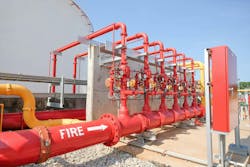Corrosion Control: The Fundamental Requirement for Data Center Cooling Reliability
Key Highlights
- Corrosion in cooling systems can lead to leaks, equipment failure, and costly downtime, impacting data center operations and financial performance
- Advanced corrosion protection methods, including vapor phase corrosion inhibitors, provide dual-phase defense during active use and standby periods, enhancing system longevity
- Proper system layup procedures, such as wet and dry preservation techniques, are crucial for preventing corrosion during idle periods, reducing maintenance costs and downtime
The current data center construction boom represents one of the most significant opportunities and challenges for HVAC and mechanical contractors. The mechanical integrity of these multi-million-dollar facilities is entirely dependent on their massive cooling infrastructure. When the cooling system fails due to corrosion—often a silent and progressive issue—a routine maintenance concern instantly escalates into catastrophic, corrosion-driven downtime.
Contractors are on the front line, responsible for the reliability of systems managing the astronomical heat loads generated by modern cloud computing and AI infrastructure. Managing corrosion is no longer an optional add-on, it is a fundamental requirement for system longevity and continuous operation.
The Operational Risks of Cooling System Corrosion
For the mechanical contractor managing data center assets, the consequences of cooling system corrosion extend far beyond simple surface rust:
Financial Impact of Premature System Failure: Corrosion weakens critical components like pipe walls, heat exchanger tubes, and chiller barrels. This leads to leaks, equipment failure, and costly emergency shutdowns. For a mission-critical data center, downtime is measured in massive financial losses (often thousands of dollars per minute), creating intense pressure on the contractor responsible for the rapid fix.
Thermal Inefficiency and Increased Operating Costs: Corrosion generates debris (sludge and rust scale) that fouls heat transfer surfaces and clogs filters and fine-bore piping. This dramatically reduces the system’s thermal efficiency, forcing chillers to operate longer and harder, which escalates energy consumption and can violate performance guarantees.
Warranty Compliance and Asset Life Cycle: Data center owners demand long service life and predictable maintenance schedules. Failure to implement robust, proven corrosion protection drastically shortens the lifespan of new or recently maintained systems, often leading to early replacement and damaging the contractor’s long-term reputation and relationship with the client.
Advanced Corrosion Protection Strategies
Effective corrosion control must address the system’s condition during its two primary states: active operation and seasonal/standby layup. One viable technology helping contractors address these requirements is the use of Vapor phase Corrosion Inhibitor (VpCI) technology.
Corrosion Protection During Active Operation
While a standard chemical water treatment program is essential, its effectiveness can be compromised in areas above the waterline or when inhibitor levels are not perfectly maintained.
Dual-Phase Inhibitor Technology: Next-generation water treatment additives are designed to offer dual-phase protection. They contain contact inhibitors to protect metals submerged in the water, and vapor-phase corrosion inhibitors that volatilize and travel throughout the system. These vapor molecules adsorb onto exposed metal surfaces above the waterline—such as the headspace of cooling towers, chillers, and associated piping—which are common weak points for conventional liquid-only treatments.
Environmental Compliance: Modern contractors must increasingly manage environmental risks. Using advanced inhibitor packages that act as environmentally responsible replacements for traditional silicates, phosphates, or high-nitrite compounds simplifies the management of stringent wastewater disposal regulations.
Corrosion Protection During Layup (System Preservation)
The greatest threat to long-term system integrity often occurs when backup chillers or cooling towers sit idle during cool weather. With the normal chemical water treatment program suspended, residual moisture and temperature fluctuations create a highly corrosive environment for flash rust and pitting.
Wet Layup (Above Freezing): A robust inhibitor package is dosed into the standby water. It utilizes both contact and vapor-phase components to maintain comprehensive protection across all surfaces. The benefit to the contractor is the elimination of flushing requirements. The inhibitor is designed to remain in the system when it is brought back online, allowing for immediate operational readiness and minimizing labor costs and delay.
Dry Layup (Below Freezing or Empty Systems): For systems that must be drained, the risk of air-induced corrosion is high. A specialized vapor-release device or additive is applied to the empty component (chiller or cooling tower) and sealed. The VpCI technology diffuses as a protective vapor, filling the entire void space of the piping network. This creates a molecular barrier on all metal surfaces, shielding them from atmospheric moisture and contaminants. Similar to the wet layup solution, this dry preservation method does not require product removal. When the system is ready to be refilled and started, the protective layer dissipates harmlessly, ensuring immediate readiness for service.
Proactive Asset Preservation
The scale and necessity of data center cooling demand a new standard for mechanical integrity that goes beyond simple installation and reactive repair. By integrating proven corrosion control strategies into maintenance and service contracts, contractors provide a necessary proactive, long-term asset preservation offering.
This approach, which minimizes downtime, simplifies post-layup startup, and addresses environmental concerns is not just a best practice, it is essential for guaranteeing continuous uptime and maximizing the lifespan of mission-critical assets.
About the Author
Ana Juraga
Ana Juraga, Content Writer at Cortec Corporation has been with the company for 14 years. Besides dealing with media relations she collaborates with Cortec’s engineers and chemists in creating informative technical content. She is passionate about educating engineering community about green corrosion-inhibiting technologies and numerous advances in this field.

